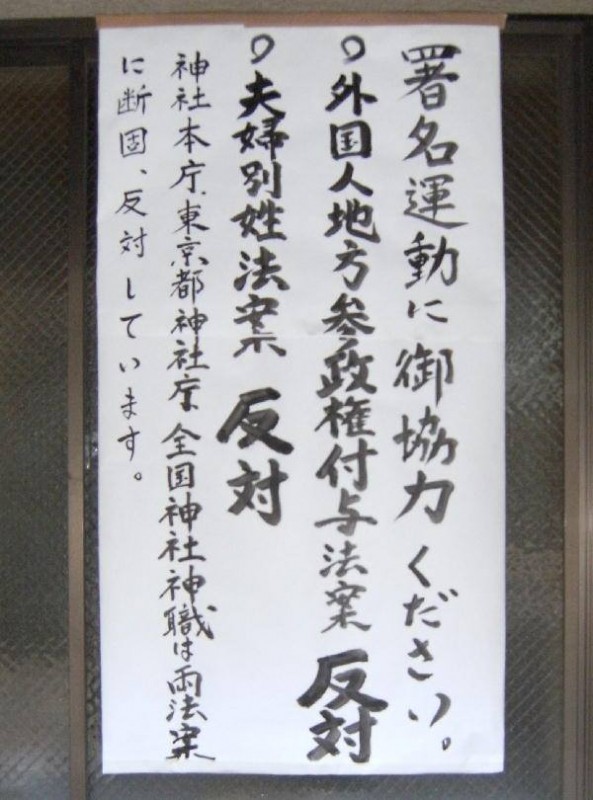
A poster at Hikawa Jinja in Saitama proclaiming a rightist agenda
Thanks to Mark Teeuwen, who has brought the above to wider attention…. He writes, ‘More campaigns by Jinja Honchō: shrine visitors are invited to sign appeals against local voting rights for foreigners (which will “turn Tsushima over to Korea and Okinawa to China”), and against married women retaining their maiden names (which will “utterly destroy the Japanese way”). Priests are finding their voice…?’
It’s disturbing, to say the least, that the official organ of a religion that should be ‘pure’ chooses to dirty itself with politics that are regressive, reactionary and, to many people, repugnant. Recent moves towards the (extreme) right have become increasingly common in Shinto circles since the election of self-confessed nationalist, prime minister Abe. The political drive to change the constitution are seen by some as a once in a lifetime chance to reintroduce elements of State Shinto.
These are worrying times. At a time of increasing environmental degradation, one might hope for the spirit of collaboration, equality and the urgent promotion of ecological policies. Rather than denying married women the right to choose their own surname, how about more concern for the protection of nature (Shinto is an animist religion)? Rather than denying voting rights to foreigners (ie Korean and Chinese permanent residents), how about seeking cooperation and facing up to war crimes with ‘sincerity’ (a key Shinto value)?
Where, in short, are the progressive elements that Shinto so badly needs?

Getting rid of 300 years of Sakoku is not an easy task, and the harshness of Meiji restoration didn’t left any place for sensitiveness in managing a thoughtfull transformation. Nationalists, merchants and the american occupation destroyed what was left of Japan which now lingers somewhere in some people’s psyche.
We can only wish more openness on the part of the japanese people but certainly not the so called “liberalism” engineered by the very criminals who swapped a bronze mirror for a plastic one.
Please forgive my awfull english, faithfully yours.
Thank you for your input, and your English is far from awful. I presume the ‘liberalism’ you refer to is that of the Liberal Democratic Party (often said to be neither liberal nor democratic, and not much of a party either but one of personal factions or fiefdoms). Are they the ‘criminals’ you accuse of swapping a bronze mirror for a plastic one (nice metaphor)?
The criminals are those who favor money over everything else and I’ll gladly throw the whole bunch of the political spectrum in the basket. The Globalist Foly(tm) will try to extract every sliver of the Mitama of whatever can be reduced to a quantity by the cunning use of Emotion and Greed. I really wish that Japan can continue to thrive, in particular the wonderful array of spiritual practices from Kami Asobi to the austere Shikatanza. The carnal relation to spirituality of the japanese culture is vital. But i’m afraid they’ll try to smother everything under a thick slice of pink and greasy “Cool Japan”. It’s the Namahage versus Kyari Pamyu Pamyu!
Thanks for that input, though there’s a thick slice of cultural references that probably need explication for those not familiar with Japan. Kami asobi is the offering of song, music and dance etc for the entertainment of the kami. Shikatanza, or ‘just sitting’, is the name of zazen in the Soto Zen tradition. Namahage is a demon that features in Tohoku folklore and festivals, while Kyari Pamyu Pamyu is a young and particularly cute female singer who exemplifies ‘kawaii’ culture. It’s a remarkable feature of contemporary Japan that traditional practices like Shugendo continue to thrive alongside the skyscrapers, robots and Smap-type entertainment. Perhaps one way of viewing the present government’s move towards nationalism is as a reaction against the threat to Japan’s cultural identity by the forces of globalisation.